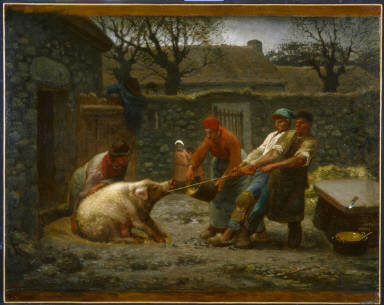 |
| (photo source) |
So what has this to do with St. Martin of Tours and old agricultural observances? As Bertelson explains, the choice of the 11th hour on the 11th day reveals the Catholic traditions that many of the Allies shared, in particular that November 11th is the Feast Day of St. Martin of Tours, patron saint of soldiers, beggars, vintners, innkeepers, and geese (yes, there's a Martinist story behind the geese, those darn loud-mouths [!], which you can read on Bertelson's post!). The significance of beggars hired to work in the vineyards is clarified if you read all of Chapter 20 in Matthew--see here--e.g., he who is last shall be first, "for many are called but few chosen," a notion that also has been applied at times to soldiers.
 |
| Jean-Francois Millet, Killing the Hog, National Gallery of Canada, late 1860s (source) |
Many of us don't like to think about such slaughter, but it was a necessity at the time to put food by to get through the lean winter ahead. (The Bible often uses harvest and slaughter as parables for the cycle of life-death-life; even Jesus was not a vegetarian--click here for a Red Hill Root article on the controversy over Jesus' dietary habits; see page 5.) Hence the harvest also was a time of feasting for all (starting at the 11th hour), including beggars and serfs, with goose often featuring in the feast. I have to say, however, that Millet's painting, above, always makes me sad, as pigs and hogs are such intelligent animals, and the hog knows what's coming up (or coming down) for him or her. The children watching in the background are there to reinforce the notion of cyclical life-death-life, as, when they mature, they too will kill the hog.
Finally, the wheat that had been harvested, again reinforcing both pre-Christian and Christian concepts of life-death-life, was baked into bread loaves shaped like humans, as shown in this lovely, atmospheric photograph by Cynthia Bertelsen.
 |
| Martinmas bread, photo by Cynthia Bertelsen (source) |
No comments:
Post a Comment